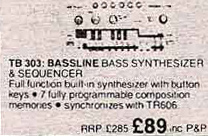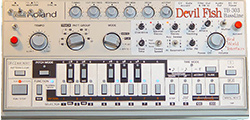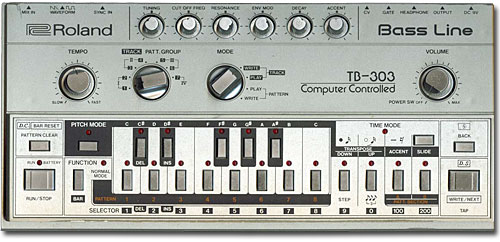 The Roland TB-303 Bass Line is a synthesizer/sequencer manufactured by the Roland corporation in 1982 and 1983 that had a defining role in the development of contemporary electronic music.
The Roland TB-303 Bass Line is a synthesizer/sequencer manufactured by the Roland corporation in 1982 and 1983 that had a defining role in the development of contemporary electronic music.
The TB-303 (named for “Transistor Bass”) was originally sold to guitarists for bass accompaniment while practicing alone. Production lasted approximately 18 months, resulting in only 10,000 units. The TB-303 is considered a collector’s item today, often valued at US$800 to 1000. It was not until the mid- to late-1980s that DJs and electronic musicians in Chicago found a use for the machine in the context of the newly developing house music genre.
 {ln:DJ Pierre ‘Phuture’s} “Acid Trax” is widely acknowledged to have been the first Acid House recording to incorporate prototypical TB-303 sounds. Earlier recordings featuring the TB-303 can be traced back as far as the early Electro scene, including artists such as Ice T, Newcleus, and {ln:Mantronix}, as well as pop musicians such as Heaven 17 and Section 25.
{ln:DJ Pierre ‘Phuture’s} “Acid Trax” is widely acknowledged to have been the first Acid House recording to incorporate prototypical TB-303 sounds. Earlier recordings featuring the TB-303 can be traced back as far as the early Electro scene, including artists such as Ice T, Newcleus, and {ln:Mantronix}, as well as pop musicians such as Heaven 17 and Section 25.
In the early 90’s, as new Acid styles emerged, the 303 was often overdriven, producing a harsher sound.
The well-known “acid” sound is typically produced by playing a repeating melody on the TB-303, while altering the filter’s cutoff frequency, resonance, and envelope modulation. The TB-303’s accent control modifies a note’s volume, resonance, and envelope modulation, allowing further variations in timbre. A distortion effect, either by using a guitar effects pedal or overdriving the input of an audio mixer, is commonly used to give the TB-303 a denser, noisier timbre.
The designer of the TB-303, Tadao Kikumoto, was also responsible for the TR-909 drum machine.
The TB-303 has a single audio oscillator, which may be configured to produce either a sawtooth wave or a square wave. It also includes a simple envelope generator, with a decay control only. A lowpass filter is also included, with -18 dB per octave attenuation, and controls for cutoff frequency, resonance, and envelope parameters.

The TB-303 has some unique features that contribute to its characteristic sound. During the programming of a sequence, the user can determine whether a note should be accented, and whether it should employ portamento, a smooth transition to the following note. The accent circuitry, as well as increasing the amplitude of a note, also emphasises the filter’s resonance, resulting in a distinctive “wow” sound at higher resonance settings. Roland referred to this as “gimmick” circuitry. The portamento circuitry employs a fixed slide time, meaning that whatever the interval between notes, the time taken to reach the correct pitch is always the same.
The instrument also features a ‘simple’ step-time method for entering note data into the 16-step programmable sequencer. This was notoriously difficult to use, and would often result in entering a different sequence than the one that had been intended. Some users also take advantage of a failure in the unit, wherein patterns that are programmed in memory begin to vary in random ways if the batteries are removed for a time.
 There have been many modifications designed for the TB-303 such as the “Devilfish“, “Acidlab” and “BORG” modifications. These generally provide additional parameters to the player, or offer alterations to the overall timbre.
There have been many modifications designed for the TB-303 such as the “Devilfish“, “Acidlab” and “BORG” modifications. These generally provide additional parameters to the player, or offer alterations to the overall timbre.
Around the middle of the 1990s, demand for the TB-303 surged within the electronic dance music scene. As there were never many TB-303s to begin with, many small synthesizer companies cropped up and started to develop their own TB-303 hardware clones. This new wave of TB-303 clones began with a company called Novation Electronic Music Systems, who released their portable Bass Station keyboard in 1994. Many other TB-303 “clones” followed, including Future Retro’s 777, Syntecno’s TeeBee, Doepfer’s MS-404, and MAM’s Freebass FB-383. As the popularity of these new TB-303 clones grew, Roland, the original TB-303 manufacturer, finally took notice and released their own TB-303 clone in 1996, the MC-303 Groovebox. Despite Roland’s efforts, their new “303 clone” was an entirely new product that had almost nothing to do with the original TB-303, with the exception of a few bass samples and the familiar interface design. The most obvious difference was the inclusion of an inexpensive digital synthesiser, rather than the analog circuitry of the TB-303.
